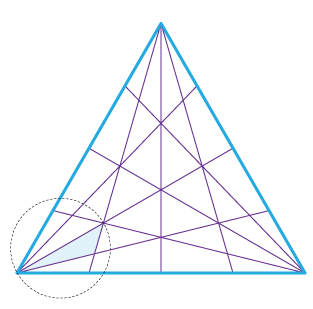Consider a standard simplex with points $(p_1, \dots, p_n)$, $p_i \ge 0$, and $\sum_i p_i = 1$. Fix a set $\{q_k\}_{k=1}^K$ with $0\leq q_k \leq \infty$ and $i,j\in\{1, \dots, n\}$. Partition it via the hyperplanes characterized by $p_i = q_k p_j$ into "cells" so that each cell is the intersection of one of the half-spaces generated by each hyperplane. (For concreteness, for the case of the 2-simplex, I have in mind a triangle. There are $K$ lines emanating from each vertex, intersecting the opposite edge of the triangle. These lines subdivide the triangle into a number of disjoint regions, which I am calling cells. Note that there are $K{n \choose 2}$ hyperplanes, so each cell is an intersection of $K{n\choose 2}$ half-spaces.)
Suppose that the $\{q_k\}$ are such that the hyperplanes are "evenly spaced." By evenly spaced, I mean that $\{q_k\}$ is such that $q_k / (1+q_k) = k / (K+1)$. (In the 2-simplex, this corresponds to the lines dividing the opposite edge into equally spaced segments.)
What is the maximal diameter of one of the cells of this partition, as a function of $K$ and $n$? Is there a way to compute a (reasonable) upper bound for this diameter? (An answer even for the 2-simplex would be very helpful!) Suppose for concreteness that we are looking at the Euclidean metric induced from the ambient space, with all edges having side length $\sqrt{2}$.

